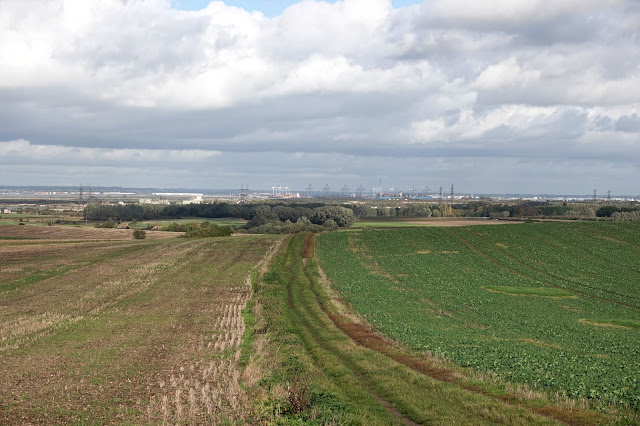Thursday saw me amble out for another local circuit with a
view to getting to some farmland. My
route took me up to the end of my road (where the Rowans are just perfect for
Waxwings) where I found a still flowering patch of Ivy in and ally and could
smell it before I got there. It was
heaving with Common Wasps, flies and a couple of Honey Bees but no late Ivy
Bees. Most of the flies were Calliphora
with a few Lucilia and it was good to see some Hovers too with Eristalis tenax
and pertinax, a female Eupeodes luniger and Episyrphus balteatus.
 |
Ornamental Cherry
|
 |
Common Wasp
|
 |
| Calliphora sp |
 |
| Eristalis pertinax |
 |
| Eupeodes luniger |
 |
| Episyrphus balteatus. |
 |
Lichen on the back of roadsign
|
 |
Will see if Enid or Bob can help with the id...
|
I said hello to the rooftop Pigeons as I walked down
Crutches Lane and they all looked up to show me a female Sparrowhawk circling
above. The Gean and Maples glowed as I walked down towards Great Crabbles Wood
but I decided to stay on the lane and head into Higham the fields beyond
passing a fiery orchard that I think were Pear trees tucked at the back of a
field.
 |
Napping Pigeons - but no for long
|
 |
Sparrowhawk
|
 |
Shepherd's Purse
|
 |
Pear Orchard
|
 |
Crutches (Kroo Chez) Lane
|
I wandered past Gads Hill School and then into Higham where
a Starling was chortling away on a chimney pot to no one in particular with his
pulsating glossy beard and I could hear Goldcrests in the gardens. Some of the
front gardens here are so long that you can’t see the house at the top.
 |
Starling
|
I turned onto a new footpath to get out into the fields and
found a few more patches of Ivy with the same insect selection before emerging
into the expansive view out over Cliffe Pools, Northward Hill and the Essex
coast from DP World to the Southend Seafront.
The fields that held rape and wheat are now bare but I was
pleased to discover a good numbers of Skylarks cavorting across the bare ground
but favouring the rape fields where there was already some regrowth to provide
cover. Amongst them were a few Meadow Pipits
and Linnets and at least 22 Corn Buntings which hopefully stem from the
breeding birds I found here in the springtime. Both Larks and Buntings were even
jollied into song by the weak sunshine but relatively warm air.
 |
Corn Bunting - easy to lose them out here!
|
I looped around an had a listen at the deep chalk pit out in
the middle as the Sycamores were crying out for a Yellow-browed Warbler and the
side wall thickets for something rarer but all I left with were a few
Chaffinches and a Dunnock. Two Small
Whites flew by and I looked at all the fence posts for my first home-walk
Stonechat but had no joy while Chicory, Yarrow and Bristly Oxtongue were still in bloom in a patch of game bird Brassica cover.
At Hermitage Lane I turned left and went past the one and
only duckpond that I have encountered on these strolls and where it had
overflowed onto the road the House Sparrows were avidly flapping in a
puddle in between disturbance from passing cars. Pied Wagtails were in the paddocks but no
winter thrushes were seen.
 |
A beautifully clipped Yew hedge adorned with translucent glowing fruits
|
 |
Flapping in a puddle -
|
 |
A Poplar loving Lichen
|
Another new path took me down to Dillywood where I
overlooked the salad fields that I had watched grow on my first walks. They are already ready for another haircut
and the arrow straight lines created some strong patterns across the landscape.
From here I was back on the road until diverting into Broomhill
Park. The kids seem to already be off around here and it was full of balls,
boards and bikes but the Acer leaves were worth the diversion.
 |
Acer
|
 |
|
Buck's-Horn Plantain (Plantago Coronopus) I have found this on most local pavement edges
|
As I dropped
down the other side I found my best clump of Ivy of the day but the poor light
precluded any good shots but I did see my fist and probably only Ivy Bee of the
year along with the same Hoverfly assortment as earlier but with a few additions
with three Cheiloisa soror, two Myathropa florea, Syrphus ribesii and two
Platycheirus albimanus. There were heaps
of Wasps and a tiny Fruit Fly, Pollenia sp, Sarcs, Blues and Greens but best of
all was a male Stomorhina lunata –the Locust Blowfly - that would not just stay
still long enough for a photo in the shade.
I have seen this scarce migrant a couple of times at Rainham now so it
was nice to see one close to home.
 |
Seven Spot Ladybird
|
 |
Sarc - a Flesh Fly
|
 |
Pollenia sp with those golden hairs!
|
 |
Pollenia sp again I think
|
 |
Calliphora sp
|
 |
Myathorpa florea and tiny friends
|
 |
and a tiny fly buddy
|
 |
| Calliphora sp |
 |
Cheilosia soror
|
 |
Common Wasp
|
 |
Stomorhina lunata – Locust Blowfly from RSPB Rainham Marshes 30th September 2019
|
A final shot of a roosting Black-lipped Hedge Snail and a
glance up at the darkening heavens and it was time to make the final downhill
stretch to home.














































thank you Howard, very intersting as always
ReplyDelete